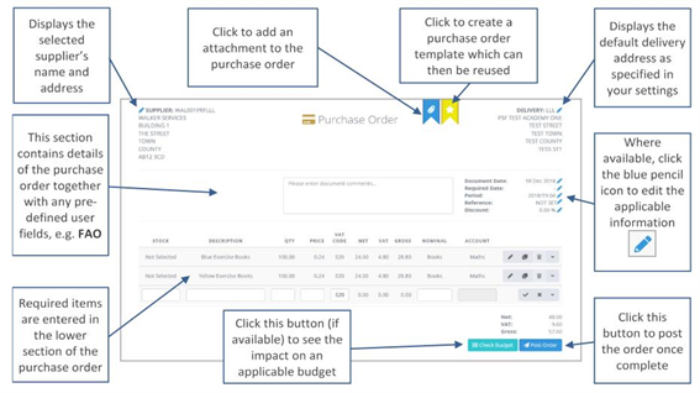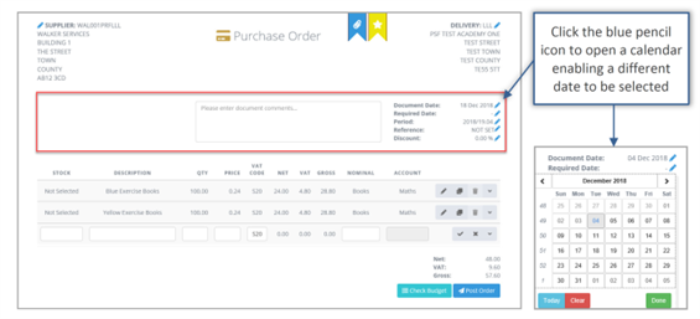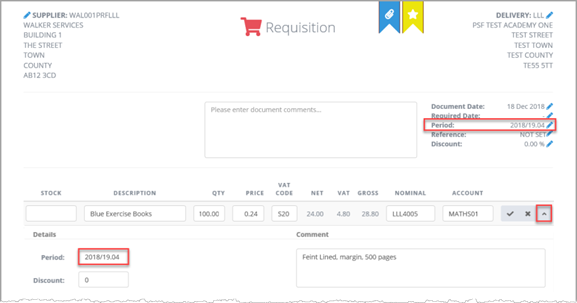Creating a New Purchase Order
In IRIS Financials Purchasing you can create a new purchase order without having previously entering a requisition. This process should be used if your establishment/organisation either do not have or use an internal process for requisitions. You can also raise a purchase order from an existing, authorised requisition. For more information, refer to Raising an Order from a Requisition.
Creating a purchase order consists of the following:
Completing the Purchase Order Details
Adding Required Items to the Purchase Order
Checking the Budget Before Posting
Creating the Purchase Order
- From the Home page, click Order.
-
The Select your Supplier window is displayed. Either scroll through the list or search for the required supplier using the Search Criteria field at the top of the window. You can enter any element of the supplier account code or name/title. The list is then reduced based on the criteria entered.
By default, any element of the supplier account code, name/title is searched. If you find the search is taking longer than expected, deselect Advanced Search.
- Click to select the required supplier. The Select your detail lines window is displayed. Click New.
- A blank Purchase Order is displayed.

Completing the Purchase Order Details
The delivery address defaults to the address specified in the Current User settings tab (accessed by clicking the Settings icon on the Home page). This is usually your establishment/organisation address, however here may be multiple delivery addresses for separate departments, locations, etc.
- If there is no delivery address displayed, or you want to change the delivery address, click the blue Pencil icon to edit the address.
- From the Select your Delivery Address window, click to select the required address.
- The centre section of the document is used to complete details relating to order.

- Click the blue Pencil icon to open a calendar to select a different date.
- Complete/edit the remaining order information as follows:
Comments
Enter any comments relating to the purchase order. There are two potential uses for the comments field:
-
You can add comments to be used internally (for example, to provide information for the purchase order authoriser, such as See attachments for quotes). It is important to note that these comments are also available to the supplier once the Purchase Order is sent therefore comments need to be removed by the authoriser before they authorise the order.
-
You can add comments for the supplier, such as delivery instructions or any special requirements.
Document Date
Is populated with the current date. This can be changed to any historic date by clicking the blue Pencil icon, select the required date from the calendar, then click Done. For example, this may be required if you want the system purchase order to match an internally generated purchase order document. Enter the date that the item(s) are required by.
Required Date
Click the blue Pencil icon, select the required date from the calendar, then click Done.
Period
Defaults to the current accounting period. If you need to change the date for a retrospective purchase order, click the blue Pencil icon, select the required date from the calendar, then click Done.
If you change the accounting period in the purchase order details, the accounting period for each item line is not automatically updated. This is intentional as you may want an individual item posted to a different accounting period. As a consequence, if you amend the accounting period in the purchase order details and have existing items in the purchase order, the period for each item line in the additional information section should be check to ensure it correctly reflects the required account period. Click the down-arrow at the end of the applicable item line, as shown in the following graphic.
Reference
Enter any required reference in Reference, such as a quote number, an establishment/organisation reference number, etc. The reference is carried through to the Goods Received Note when the Purchase Order is authorised.
Discount
If you know a discount is available for the order when it is placed, enter the details here. The discount is applied to all the item lines in the Purchase Order. If required, you can edit the discount for any individual item lines by clicking the down-arrow at the end of the required item line. 
Any discounts entered are carried through to the next document in the purchasing process - in this case, the Goods Received Note (and then Invoice).
Adding Required Items to the Purchase Order
When the document details have been completed, you can proceed to enter the items for the purchase order. The process should be carried out for each required item.
- If known, enter the supplier item stock code in STOCK, then press the Tab key to move to the next field.
If a supplier catalogue has been imported into IRIS Purchasing, when you hover over STOCK, a Magnifying Glass icon is displayed. Clicking the Magnifying Glass icon enables a stock code to be selected, which automatically populates Description and Price. - Enter a description for the item in DESCRIPTION, e.g. Blue Exercise Books.
An unlimited number of characters can be entered but only 30 characters are displayed in DESCRIPTION. The system automatically copies any description over 30 characters to Comments in the additional information section. You can view this by clicking the drop-down arrow on the far-right of the item line.
- Enter the quantity in QTY and unit price in Price for the item (do not enter any currency symbols, i.e. £, $, etc.)
- The VAT CODE defaults to the standard rate (this setting can be amended by your System Administrator and may be different). If the VAT Code is not known, this can be amended during the invoice stage. However, if you need to amend the VAT Code, hover over VAT CODE, click the Magnifying Glass icon, then click to select the required VAT Code.
- The NET, VAT, and GROSS are automatically calculated.
- Hover over Nominal, click the Magnifying Glass icon, then click to select the required nominal from the Select window. Alternatively, enter a relevant word, e.g. book in Nominal. The system then displays any matching nominals, select the required nominal from the drop-down list.
- Choose the cost centre account to which the item should be charged (this can only be done once a nominal has been selected). Hover over Account, click the Magnifying Glass icon, then click to select the required cost centre from the Select window. Alternatively, enter a relevant word, e.g. maths in Account. The system then displays any matching nominals, select the required nominal from the drop-down list.
A default cost centre account can be set up in the General tab on the Settings window (accessed by clicking the Settings icon on the Home page). If this setting is not available, please contact the person within your establishment/organisation who administers your system, i.e. has a CUSTADMIN login.
Adding Additional Item Information
Additional information can be added to each item by clicking the down arrow on the far right of the item line.
The fields that are displayed in the Details section are defined by the person within your establishment/organisation who administers your system, i.e. has a CUSTADMIN login


You can apply a specific Period or Discount to the item by amending the applicable field. You can also add additional information in Comment.
If you change the accounting period in the purchase order details, the accounting period for each item line is not automatically updated. This is intentional as you may want an individual item posted to a different accounting period. As a consequence, if you amend the accounting period in the purchase order details and have existing items in the purchase order, the period for each item line in the additional information section should be check to ensure it correctly reflects the required account period. Click the down-arrow at the end of the applicable item line, as shown in the following graphic. If you previously entered more than 30 characters in the item Description, the full description is displayed in Comment.
If you previously entered more than 30 characters in the item Description, the full description is displayed in Comment.
Validating an Item Line
When you have finished adding the item information, click the Tick icon to validate the line. 
If the validation fails, an error message is displayed on the top right-hand corner of the purchase order, and the incorrect fields are displayed in red with a message displayed. 
Correct or enter the required information, then validate the item again. Further items cannot be added until the line has been successfully validated.
Adding More Items
When the item line has been successfully validated, a new line is automatically created. The total Net, VAT, and Gross for the purchase order are automatically updated to reflect the validated items. 
The icons to the right of the validated item line can be used to make amendments as follows:
|
Icon |
Description |
|
|
Click to edit the item details. You need to validate the item once complete, irrespective of whether any changes have been made. |
|
|
Click to produce a copy of the current item that can then be amended and validated. |
|
|
Click to delete the current item. |
|
|
Click this to view any additional information about the item including for example Period, Discount and Comments. The fields displayed here are defined by your System Administrator and consequently may vary from these. The icon switches to an up arrow enabling the additional information to subsequently be closed. |
|
|
Click this to validate any new or amended item line. |
Complete the new item information as previously described. if the item is similar (for example, yellow exercise books), it can save time to copy the existing item line, then make amendments as described in the following section.
If delivery charges are known at this stage, they should be added as an additional item line. It is best practice to only add them if you have access to the correct nominal/account to which delivery charges should be applied. If in any doubt, do not enter the deliver charges as these can be added at the invoice stage, or check with the person within your establishment/organisation who administers your system, i.e. has a CUSTADMIN login.
Copying Existing Items
To copy an existing item, click the Copy icon on the right-hand side of the item line to be copied. A new line is displayed with exact same content.
Make the required amendments.
Validate the line in the usual way. The Net, VAT, and Gross for the purchase order are automatically updated to reflect the new item(s).
Viewing or Adding Attachments
You can add attachments to the purchase order at any point during or after it has been created. For example, you may want to attach a quote, email, a photo, etc. For more information, refer to Adding Attachments to Documents.
Checking the Budget Before Posting
Depending on how your system has been set up, you may see Check Budget at the bottom of the purchase order. This functionality is often used by cost centre managers, such as heads of department, to check the impact of this order on their budget.
If Check Budget is displayed, clicking it allows you to see the impact of this purchase on the selected budget/nominal and whether the item is within budget limits etc. In the following example, the order falls within the applicable budget and therefore the line is displayed in green. If the order goes over budget, the information is displayed in red. Click Back if you need to return to the order to make amendments. The name of the budget the items are being checked against is displayed in the bottom left-hand corner of the Budget Information window.
This window may look slightly different if your system has been set up to check a budget at account level. In this case, it is grouped on account code and a nominal column is not displayed.
Posting the Purchase Order
If this purchase order is one that you are likely to use again, i.e. the items are to be regularly ordered, you can save this purchase order as a template that can be used. For more information, refer to Creating Document Templates.
- When all the required items have been entered and validated, click Post Order.
- Error messages are displayed if any of the item lines have not be validated or data is missing (the affected fields are highlighted).
- Depending on how your system has been set up, the Budget Information window may be displayed. In the following example, In the following example, the order falls within the applicable budget and therefore the line is displayed in green. If the order goes over budget, the information is displayed in red. The name of the budget the items are being checked against is displayed in the bottom left-hand corner of the Budget Information window.

This window may look slightly different if your system has been set up to check a budget at account level. In this case, it is grouped on account code and a nominal column is not displayed. - Click Edit Document to make any amendments to the purchase order based on the budget impacts or click Proceed to post the purchase order.
- When the purchase order has been successfully posted, a purchase order document number is automatically generated, and a success message is displayed in the top right-hand corner of the window. Click the message displays a read-only copy of the purchase order.
- By default, the Home page is then displayed. This can be changed via the Current User tab in settings (accessed by clicking the Settings icon on the Home page), so that the read-only version of the document is automatically displayed. For more information, refer to Personalising IRIS Purchasing.
- The purchase order is now ready for authorisation. An email is sent to the person responsible for authorising the purchase order.





